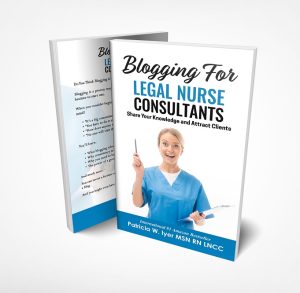Do you vary your blog content to make a memorable blog?
Vary Your LNC Blog Content
Add Spice to Your Blog
Whether you write blogs about medical malpractice or personal injury, you must fulfill one primary responsibility if you want readers to revisit your website and subscribe.
I heard two consistent messages at the NSA conference in July 2023: use humor and tell stories in your presentations. These elements are critical in blogging also.
Use humor
Humor is more commonly an element of a story than a story in itself, although you can also devote a blog to a humorous story.
We enjoy laughing. Dry humor, self-deprecating or ironic writing, and other methods lighten our day. You do not have to be a stand-up comic to introduce a light tone to your blog posts.
Every business and profession has its humorous aspects. Health care is full of laughable moments.
Be careful to avoid sarcasm, which can come across as cruel. Never use humor that relies on racial, sexual, religious, or other stereotypes based on bigotry.
It is inappropriate to use humor when writing about certain subjects. Use your best judgment if you are writing about bigotry or subjects involving grief and loss. If you are unsure, get advice.
Be mindful about using humor, but do not be afraid. Laughter is healing, and a dense subject can often benefit from a light flavoring of comedy.
You do not have to be the author of the humor you use. Collect humorous quotations and file them by topic. Also, collect stories—which brings me to the following way to make your blog posts memorable.
Tell a story
One of the fascinating aspects of the cave paintings in Lascaux, France, is that they provide a vivid record of the fact that 15,000 to 17,000 years ago, people were telling stories, in this case, painting them.
Stories are essential parts of our human heritage. We have been conditioned since childhood to settle down to have books read to us or family histories recounted. Bloggers who open a post with a story engage their readers and use the story to make a point.
A delightful story illustrates one of the key points of writing: “Show, Don’t Tell.”
To say, “Always do what you have to do,” is telling. It does not encourage acceptance of a principle but the opposite. You may ask, “Why?” You might think, “What if you could get out of it and do something else?” You might also think, “Who are you to tell me what to do?”
Drafting a relevant story can take practice. It would help if you learned how to engage your reader’s interest, activate as many senses as possible, and tell your tale as briefly as possible.
This skill is well worth learning. It can make the difference between a blog that quietly gathers dust and one that goes viral.
Put yourself into your blog
Sharing about yourself deepens your connection to your readers. People are not only interested in what you write, but they also want to know who is writing it.
As with humor, you want to use discretion. As a legal nurse consultant with a long work history, both clinically and as an LNC, I often include in my blogging stories about nursing experiences, business lessons learned, and stories about my writing career. I am careful not to provide identifying information regarding other people involved in these stories.
I do not write personal details about my family life, and I am very careful about what I write about my sons. They have the right to their privacy.
You could apply that principle to anyone you write about other than yourself. Change names, alter identifying details, and be careful about personal information.
It is not safe to blog about an open case. Please wait until it is finished before describing the story and lessons learned. Also, be aware if the settlement amount is confidential before you share that detail.
Share lessons learned
Keeping all the above cautions in mind, sharing lessons learned is a compelling way to establish rapport. Isn’t it more helpful to learn from someone else’s mistakes than to make them ourselves? Wouldn’t you like to avoid the embarrassing mistakes that someone reveals in a blog post? Often combined with sharing a lesson we learned the hard way, a touch of humor lightens the story.
Adding lessons learned serves another purpose. If your blog is about your LNC business, you can write the lesson in a way that shows how you improved your LNC business because of what you learned.
The subject of sharing lessons learned will also contain story elements and perhaps humor and personal information about you.
Sharing these lessons, while it can be part of a blog, can also be a blog in its own right.
In the Event of a Water Landing
Your blog allows you to share stories and your reaction to stories. For example, the first blog I ever wrote was about Captain Sully’s plane landing in the Hudson River. It was such a compelling incident that I wanted to share my reaction to his heroic effort to save the people from plunging into the icy Hudson River. I lived about an hour and a half away from the site of the landing; it was a personal story of intense interest to me.
I had heard that expression: “in the event of a water landing” and had thought, “Yeah, right.” But that blog post was the first step towards sharing the information: my sharing a reaction about courage in extraordinary circumstances. And the lesson: You CAN survive a water landing.
Share your workday
Describing your workday serves two purposes. If you write such a post in the initial stages of your blogging career, it gives people a chance to know you. And your LNC business. By introducing your business and your role in it, you say, “This is what’s important to me.”
In an early blog, you might want to give your readers a virtual tour, photographs, or short videos.
If you write a blog sharing your day at a later stage when you have more readers, you may choose to go into greater depth.
As a legal nurse consultant, while preserving your clients’ anonymity, you could explain why you take the clients you do. You might describe some of the closed cases you have resolved for them.
If you have a sizable audience, you allow them to preview what working with you would be like. You give them a behind-the-scenes view of how you do things. They get to see how your business looks from your vantage point.
Elements you can include in this kind of blog:
- What is your morning routine?
- What sorts of meetings do you have?
- What strategies do you use to be productive?
- What do interactions with your team look like?
If you want to get more personal, you can also describe your nightly routine and what you do to unwind.
Your goal is to give others a sense of your day. If possible, you also want your readers to learn valuable lessons from how you go about your day.
For example, you work out early each morning because it helps you feel energized throughout the day. Communicate that to your readers.
Or you do yoga every evening because it helps you to relax. That is a great tidbit to share with your audience and something they can learn.
How to Inject Your Personality into Your Blog
When people first started blogging, many used their websites to inject their personality into their blogs. They ranted (and raved).
Today, business blogs may serve many purposes. They educate, persuade, and entertain in today’s impersonal world, which can make a critical difference in who a potential client or customer chooses.
Showing Your Personality
Your blog allows people to know, like, and trust you. It provides a way to let people know who you are, beyond your degrees and expertise. For example, you might recount a struggle over a bill with a particular company and describe how that reminded you of the importance of caring customer service.
You might then give some examples of customer care practices in your business. This could be an effective way to work in customer testimonials.
Revealing your personality gives you a chance to say, in several ways, that you do not simply want someone’s business; you want to establish a relationship.
Creating quotes with beautiful images is one way to illustrate your blog. Providing inspiring quotes illustrated by photographs or within a photograph is a top technique that professional bloggers use to break up the text.
I have used this source for several years to get high-quality images for my blogs, books, PowerPoint presentations, and more. There is a vast variety of photos, vectors, fonts, templates, and icons. Go to http://mywriting.tips/images. This is my affiliate link, and I will earn a few dollars if you sign up at this link.
Here’s a collection of tips about varying your blogging format.
- Choose one quotation and comment on it at length.
- Tell anecdotes about your LNC business that give it the human touch.
- Highlight how your company serves its community.
- If you have individual employees who made outstanding contributions, write about them.
Common Questions About Blog Content
Do your memorable blog posts follow the 80-20% ratio?
That ratio means 80% information and 20% sales (preferably soft). You might mix up how you follow this ratio. It could mean several posts devoid of promotion followed by one promotional post. You may use a news item to highlight your company values and/or mission statement.
What length are your blog posts?
As of this writing, Google prefers some of the posts to be longer (around 1500-2000 words). I recommend a mix of different lengths, with 300 words being the bare minimum. Recommended length changes periodically, so do a Google search for the ideal blog post length in (YEAR).
What kind of response rate are you getting to your blogs?
As with evaluating newsletter unsubscribe rates, you need to do some detailed analysis. Both subscribe rates and comment rates indicate the popularity of a blog in general, and they can also show interest in specific subjects.
You might find that people are most interested in hot topics. That will not give you specific topics, but you will know to focus on current news as the subject matter.
 Get specific tips about writing LNC blogs by purchasing this book, available in instant download on this site at LNC.tips/creatingseries, or at Amazon in paperback of Kindle format.
Get specific tips about writing LNC blogs by purchasing this book, available in instant download on this site at LNC.tips/creatingseries, or at Amazon in paperback of Kindle format.
If your blog posts do not draw comments, think about different ways to encourage responses. But do not take it seriously; people are less likely to comment on blogs than they used to.
Do you link your blogs and newsletters?
Your blog should be on your website, and you can link to the more business-oriented sections of the site. A useful way to do this on a blog is to write brief summaries of new information on your website with links. Always look for ways to make these connections and link newsletters and blog posts to your website.

Pat Iyer is president of The Pat Iyer Group, which develops resources to assist LNCs in obtaining more clients, making more money, and achieving their business goals and dreams.
Pat’s related websites include the continuing education provided on LNCEU.com, the podcasts broadcast at podcast.legalnursebusiness.com, and writing tips supplied at patiyer.com.
Get all of Pat’s content in one place by downloading the mobile app, Expert Edu at www.legalnursebusiness.com/expertedu. Watch videos, listen to podcasts, read blogs, watch online courses and training, and more.

